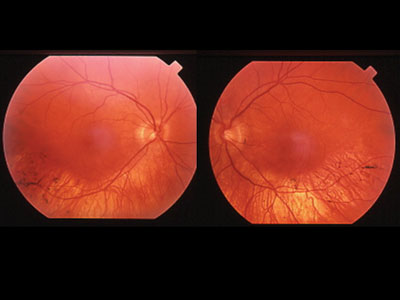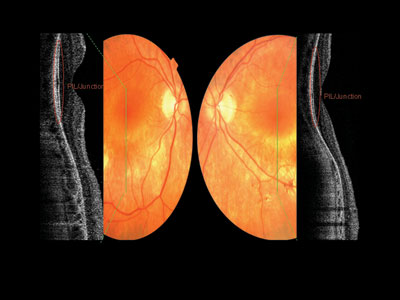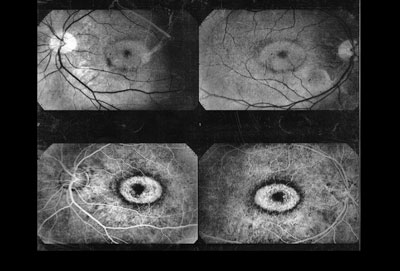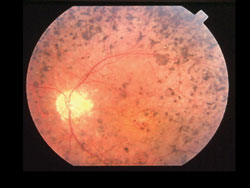Consider genetic testing if clinical retinal picture is inconclusive
A 58-year-old patient comes in for a routine eye examination, claiming he only needs reading glasses. His best corrected visual acuities are 20/20 in each eye. He has no other vision complaints and is in good health.
 |
Upon fundus examination, it is discovered that he has bilateral, symmetric zones of retinochoroidal atrophy along the inferior arcades with a few bone spicules. The maculae are normal. The arterioles and venules are of normal caliber. The optic nerve heads are pink and distinct, with a small degree of cupping. The remaining fundus grounds are completely normal in pigmentation.
Visual fields demonstrate superior arcuate dense scotomas that look like moderate glaucomatous field loss, yet retinal nerve fiber layer thickness is not only normal but supernormal in both eyes.
Because of the few bone spicules, the patient is asked about night vision; he reports no night vision complaints. The patient is also unaware of the bilateral superior field loss.
A full-field ERG is normal for both rod and cone function. An ocular coherence tomography (OCT) demonstrates a normal macula with absence of the photoreceptor integrity line (PIL) outside the central 10 degrees.
What is the diagnosis? You suspect a hereditary disease because of the symmetry of these unusual findings, yet the patient is unaware of any family history. Examination of family members, however, reveals that the patient’s brother, son, niece and father have similar types of changes, but were never diagnosed with a retinal disease. You, therefore, suspect autosomal dominant disease, but what disease? The findings do not fall into any classic textbook description of the diseases you learned about. Is this something new?
 Patient 1, fundus exam: This patient has bilateral, symmetric zones of retinochoroidal atrophy along the inferior arcades with a few bone spicules. Image: Bass SJ |
 Patient 1, OCT results: The macula is normal with absence of the photoreceptor integrity line (PIL) outside the central 10 degrees. Image: Sherman J |
 Patient 2, fundus exam: This patient has a central bull’s eye maculopathy in both eyes, and fluorescein angiography reveals corresponding rings of hypo- and hyperfluorescence. Image: Bass SJ
|
 Patient 2, OCT results: Note this patient’s macular thinning and an absence of the PIL at the macula (blue arrows) with presence of the PIL, although attenuated, outside the macula (red arrows). Image: Bass SJ |
In another case, a 32-year-old patient presents for a routine eye exam claiming he has never had good vision. He was told it was always due to his astigmatism.
Best corrected visual acuities are 20/40 in each eye. Fundus examination reveals a central bull’s eye maculopathy in both eyes, and fluorescein angiography reveals corresponding rings of hypo- and hyperfluorescence. Color vision is abnormal and a cone dystrophy is suspected.
An ERG, however, is found to be normal for both cone and rod function. The OCT demonstrates macular thinning and an absence of the PIL at the macula with presence of the PIL, although attenuated, outside the macula.
The patient is getting married and plans on having children. He wants to know what he has and the chances that his children will have what he has. You try to put the picture together clinically, but it does not all fit the classic, textbook case of hereditary macular disease. What do you tell this patient?
These two case scenarios are just a sample of the types of clinical dilemmas eye care practitioners face. While this may not occur on a daily basis, many clinicians do see these types of cases from time to time, or may even fail to recognize them altogether.
Both patients had been examined many times and no one ever told them they had a hereditary retinal disease, or they were misdiagnosed. Some clinicians simply refer patients to a retinal specialist or to a facility that can perform additional testing. Usually, these referrals will result in a diagnosis based on the clinical presentation and testing results. Other times, as in these two patients, the results are not clear-cut. What now?
Available tests expand
The Human Genome Project has opened the way for the identification of a number of mutations associated with many hereditary retinal diseases, and new mutations are discovered almost on a weekly basis. In the past few years, genetic testing laboratories have expanded their list of available tests for various retinal and optic nerve diseases. Is it time to start utilizing the information gained from genetic testing? When should the clinician consider ordering such testing?
 |
|
| A typical
Stargardt’s fundus: Note the granular maculopathy and lipofuscin
flecks, easier to diagnose based on the clinical picture. Images: Bass SJ  |
In the case of the first patient, genetic testing appeared to be the only option to determine if the patient had a known disease. His clinical findings did not match up with any known disease. Because other members of his family were discovered to have similar findings, the family was anxious to know the nature of the disease, if their children would be affected and if the disease would progress. The latter two questions could not be answered until the disease was diagnosed.
We originally reported this pedigree as a new disease because the pieces of the puzzle did not quite fit. Some time after, given the regional presence of some characteristics of retinal degenerative disease and the autosomal dominant inheritance, the clinical decision was made to test the initial patient, called the “proband” or “propositus” for the known autosomal dominant retinitis pigmentosa (adRP) mutations.
Genetic testing ordered
The proband’s blood was sent to the John and Marcia Carver Nonprofit Genetic Testing Laboratory (www.carverlab.org), and the adRP gene test was ordered. About 12 weeks later, we had an answer.
The proband had a Thr17Met mutation or “variance” on the rhodopsin (RHO) gene. This means that the amino acid threonine is substituted by methionine at the 17th codon in that gene. This mutation was highly associated with adRP with an estimate of pathogenic probability (EP) score of 3. The EP denotes a score that ranges from 0 to 3, with 0 being no association with disease to 3, a high association with disease.
The type of adRP associated with this mutation is a relatively mild, non-progressive form of the disease. A patient who hears about retinitis pigmentosa (RP) and searches the Internet will invariably read about the loss of night vision and the loss of peripheral vision with the potential for complete blindness — a frightening prognosis.
The accompanying figure is a classic RP fundus, easier to diagnose based on the clinical picture. Yet we are learning through genetics that there are many forms of RP, and this milder, regionalized form is not progressive. That knowledge is critical for patients who want to know what the prognosis is for the future. The expected course of an unidentifiable disease cannot be confirmed without knowing the type of mutation.
The second patient wants to know if his vision will worsen and if his children will be affected. While his fundus or phenotype suggests cone dystrophy, which can progress to cone/rod dystrophy, his ERG suggests Stargardt’s disease. The former disease affects the whole retina and may be progressive, while the latter is generally confined to the central retina and is usually nonprogressive.
The accompanying figure is a typical Stargardt’s fundus, with granular maculopathy and lipofuscin flecks, easier to diagnose based on the clinical picture. This patient is more difficult to diagnose and therefore his blood has recently been sent for genetic testing of the known mutations associated with Stargardt’s disease on the ABCA4 gene. A mutant allele in this gene associated with the type of bull’s eye maculopathy seen in this patient has just been reported in the ABCA4 gene.
When to consider testing
In summary, genetic testing for retinal disease should be considered when a patient has an atypical phenotypic presentation and the clinical picture alone is not diagnostic. In addition, because gene therapies are being investigated in an increasing variety of hereditary retinal diseases, knowledge of a patient’s diagnosis can help steer him or her to the appropriate therapy once it becomes clinically available. Laboratories offering genetic testing can be found at www.genetests.org. Ongoing clinical trials are available at www.clinicaltrials.gov.
Genetic testing of retinal disease can be performed in conjunction with the patient’s physician or a retinologist, who can draw blood and send it out for analysis. In addition, the consulting services of a genetic counselor should be considered if the ordering practitioner cannot offer information about the hereditary nature of a specific condition.
For more information:
- Sherry J. Bass, OD, FAAO, is a distinguished teaching professor at the State University of New York State College of Optometry. She can be reached at 33 West 42nd St., New York, NY 10036; (212) 938-5865; fax: (212) 938-5819; e-mail: sbass@sunyopt.edu.
References:
- Bass, SJ, Noble KG. Autosomal dominant pericentral retinochoroidal atrophy. Retina. 2006;26:71-79.
- Bass, SJ, Noble KG. A Thr17Met mutation is associated with an unusual retinochoroidopathy in an autosomal dominant pedigree. Retina. 2008;28:1013-1014.
- Cella W, Greenstein VC, Zernant-Rajang J, et al. G1961E mutant allele in the Stargardt disease gene ABCA4 causes bull’s eye maculopathy. Exp Eye Res. 2009;89(1):16-24.
